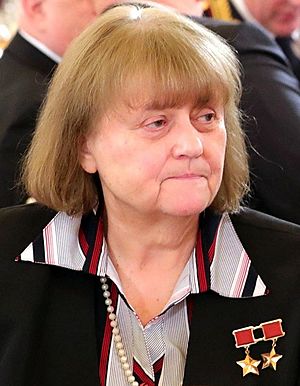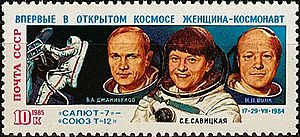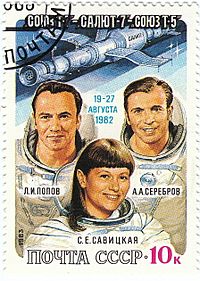Svetlana Savitskaya facts for kids
Quick facts for kids
Svetlana Savitskaya
MP
|
|
|---|---|
| Светлана Савицкая | |

Savitskaya in 2018
|
|
| Member of the State Duma (Party List Seat) | |
| Assumed office 29 December 2003 |
|
| Member of the State Duma for Moscow Oblast | |
| In office 17 January 1996 – 29 December 2003 |
|
| Preceded by | constituency established |
| Succeeded by | Dmitry Sablin |
| Constituency | Sergiyev Posad (No. 113) |
| Personal details | |
| Born | 8 August 1948 Moscow, RSFSR, USSR |
| Political party | |
| Spouse | Viktor Khatkovsky |
| Children | 1 |
| Parents |
|
| Education |
|
| Occupation |
|
| Awards | Hero of the Soviet Union (2) |
| Signature | |
| Space career | |
| Cosmonaut (retired) | |
| Rank | Major |
|
Time in space
|
19 days 17 hours 6 minutes |
| Selection | 1980 (Female Group 2) |
|
Total EVAs
|
1 |
|
Total EVA time
|
3 hours 35 minutes |
| Missions |
|
|
Mission insignia
|
|
Svetlana Yevgenyevna Savitskaya (Russian: Светла́на Евге́ньевна Сави́цкая; born 8 August 1948) is a Russian former aviator and Soviet cosmonaut. She made history by flying aboard Soyuz T-7 in 1982. This made her the second woman ever to go into space.
In 1984, on her Soyuz T-12 mission, she became the first woman to fly to space twice. She also became the first woman to perform a spacewalk. Svetlana Savitskaya set many world records as a pilot. These records were recognized by the FAI.
Contents
Early Life and Flying Career
Svetlana Savitskaya grew up in a family that was well-known. Her father, Yevgeny Savitsky, was a famous fighter pilot. He fought bravely in World War II. Later, he became a high-ranking leader in the Soviet Air Defense. Her mother was also an important leader in Moscow's Communist party.
When Svetlana was 16, she secretly started parachuting. Her father found out when he saw a parachute knife in her school bag. Instead of being upset, he encouraged her. By her 17th birthday, she had already completed 450 parachute jumps. The next year, she set records for high-altitude jumps. She jumped from 13,800 meters and 14,250 meters. Overall, she set three world records for stratosphere jumps. She also set 15 world records for jumps from jet planes.
After finishing school in 1966, she joined the Moscow Aviation Institute (MAI). There, she also took flying lessons. In 1971, she became a licensed flight instructor. After graduating from MAI in 1972, she trained to be a test pilot. She finished this training in 1976. In May 1978, she started working for the aircraft company Yakovlev as a test pilot. She was the first woman to fly a MiG-25 aircraft at a speed of 2,683 kilometers per hour. People described Savitskaya as a very serious and determined woman.
From 1969 to 1977, she was part of the Soviet national team for aerobatics. This is a type of flying that involves stunts. In July 1970, she won the world championship. She flew a Yak-18 with an all-female team. A British journalist called her "Miss Sensation" at this event. In 1972, she placed third at the World Championships. In 1976, she placed fifth.
Soviet Space Program
In 1979, Svetlana Savitskaya joined the selection process for new female cosmonauts. On June 30, 1980, she was officially chosen for the cosmonaut group. Out of nine women selected, Savitskaya was the only test pilot. She passed her final exams on February 24, 1982.
First Space Flight: Soyuz T-7
In December 1981, Savitskaya began preparing for her first trip to space. This was a short flight to the Salyut 7 space station. She was a research cosmonaut on this mission. The goal was to show Soviet strength by sending another woman into space. They also needed to replace the Soyuz T-5 spacecraft at the station.
The mission commander was Leonid Popov. The flight engineer was Alexander Serebrov.
The Soyuz T-7 spacecraft launched on August 19, 1982. This made Savitskaya the second woman in space. The first was Valentina Tereshkova, 19 years earlier. During the flight, Savitskaya said she had to tie herself down. This was to stop her from floating around due to zero gravity. The three cosmonauts docked with the space station the next day. They were greeted by Anatoly Berezovoy and Valentin Lebedev. This was the first time a space station had both men and women on board. Savitskaya had a private area in the Soyuz T-7 module. On August 27, 1982, the crew returned to Earth in Soyuz T-5. The mission lasted 7 days, 21 hours, and 52 minutes.
Second Space Flight: Soyuz T-12
In December 1983, Savitskaya was chosen for her second space flight. This mission included a spacewalk, also known as an Extravehicular Activity (EVA). This news came out three weeks after American astronaut Kathy Sullivan's spacewalk assignment was announced. The timing of Savitskaya's mission was important for the Soviet Union. They wanted her to perform the first woman's spacewalk before the Americans. Savitskaya was chosen because of her vast flying experience. She also had the physical strength needed to work in a heavy space suit. She was the flight engineer for this mission.
This was another short mission to Salyut 7. The crew brought tools to the station. These tools would help the resident crew repair a fuel line.
On July 17, 1984, Savitskaya launched aboard Soyuz T-12. She flew with Commander Vladimir Dzhanibekov and research cosmonaut Igor Volk. On July 25, 1984, Savitskaya made history. She became the first woman to perform a spacewalk. She spent 3 hours and 35 minutes outside the Salyut 7 space station. During this time, she cut and welded metals in space with Vladimir Dzhanibekov. Their main goal was to test a special tool called the Universal Hand Tool (URI). This tool could cut, solder, weld, and braze in space. During her spacewalk, Savitskaya made 6 cuts on titanium and stainless steel. She also applied 2 coatings to aluminum and tested tin and lead solder. She is the only woman among the many Soviet/Russian spacewalkers. The crew returned to Earth on July 29, 1984.
Savitskaya's and Dzhanibekov's training helped other cosmonauts. They taught two Salyut 7 crew members how to use the URI tool. This helped them fully repair the fuel line. Their mission lasted 11 days, 19 hours, and 14 minutes.
Possible Third Space Flight
After returning to Earth, Savitskaya was chosen to command an all-female Soyuz crew. This mission was planned for International Women's Day to the Salyut 7 station. She was the only experienced female cosmonaut still active. She was set to lead Yekaterina Ivanova and Yelena Dobrokvashina. However, in February 1985, contact with Salyut 7 was lost. The station was later rescued by the Soyuz T-13 mission. When another mission was stopped in November 1985 due to a commander's illness, the women's flight was canceled. Also, there were not enough Soyuz spacecraft available. Later, a flight to the Mir space station was considered. But this plan was not carried out because Savitskaya became pregnant. Her son was born in 1986.
Life After Space
Svetlana Savitskaya is married and has one son, Konstantin, born on November 7, 1986. In February 1986, she graduated from the Bauman Moscow Higher Technical School. From 1983 to 1994, she worked as a Deputy Head at NPO Energia, a major space company.
Savitskaya was a strong believer in the communist system. She was elected as a people's deputy of the USSR in 1989. She also became a people's deputy of Russia in 1990. She held this position until 1992. She was sad when the Soviet Union ended.
Savitskaya retired from the Russian Air Force in 1993 as a Major. In 1994 and 1995, she worked as a professor at the Moscow State Aviation Institute. In 1996, she was elected to the State Duma. This is a part of the Russian Parliament. She has been re-elected four times since then. As of 2025, she serves as Deputy Chair of the Committee on Defence.
FAI World Records
Svetlana Savitskaya set many world records recognized by the FAI (Fédération Aéronautique Internationale). Here are some of them:
| Date | Class | Discipline | Plane | Result |
|---|---|---|---|---|
| 6 June 1974 | turbojet | Climb to 6000 m | MiG-21 | 1:20.4 min |
| 6 June 1974 | turbojet | Climb to 9000 m | MiG-21 | 1:46.7 min |
| 7 June 1974 | turbojet | Climb to 3000 m | MiG-21 | 0:59.1 min |
| 7 June 1974 | turbojet | Climb to 12000 m | MiG-21 | 2:35.1 min |
| 15 November 1974 | rocket plane | Climb to 3000 m | MiG-21 | 0:41.2 min |
| 15 November 1974 | rocket plane | Climb to 9000 m | MiG-21 | 1:21 min |
| 15 November 1974 | rocket plane | Climb to 12000 m | MiG-21 | 1:59.3 min |
| 2 June 1975 | turbojet | Speed over 15/25 km | MiG-25 | 2683.45 km/h |
| 31 August 1977 | turbojet | Altitude in horizontal flight | MiG-25 | 21,209.9 m |
| 21 October 1977 | turbojet | Speed over circuit of 500 km | MiG-25 | 2466.31 km/h |
| 12 April 1978 | turbojet | Speed over circuit of 1000 km | MiG-25 | 2333 km/h |
| 17 January 1979 | internal combustion plane | Climb to 3000 m | Yak-50 | 4:21.4 min |
| 23 April 1981 | turbojet, take-off weight 16–20 tons | Payload at 2000 m altitude | Yak-40K | 5012 kg |
| 24 April 1981 | turbojet, take-off weight 12–16 tons | Payload at 2000 m altitude | Yak-40K | 4084 kg |
Awards and Recognition
Svetlana Savitskaya has received many honors for her achievements:
- Hero of the Soviet Union, twice (1982, 1984) - This is a very high award for bravery.
- Orders of Lenin, twice (1982, 1984) - Another top Soviet award.
- Order of the Badge of Honour (1976)
- Medal "For Merit in Space Exploration" (April 12, 2011) - For her great work in space exploration.
- Pilot-Cosmonaut of the USSR - A special title for Soviet cosmonauts.
- Honoured Master of Sports - For her achievements in sports.
- Gold Medal and 18 degrees FAI - From the international aviation organization.
- 16 gold medals, sports of the USSR - For her sports achievements in the Soviet Union.
- Special medal for the women's world record stay in space.
- Honorary Citizen of Baikonur (1982) - Baikonur is where many space missions launch.
Savitskaya was one of five cosmonauts who raised the Russian flag at the opening ceremony of the 2014 Winter Olympics in Sochi.
The asteroid 4118 Sveta is named after her.
See also
 In Spanish: Svetlana Savítskaya para niños
In Spanish: Svetlana Savítskaya para niños
- List of female spacefarers
- List of female Heroes of the Soviet Union



